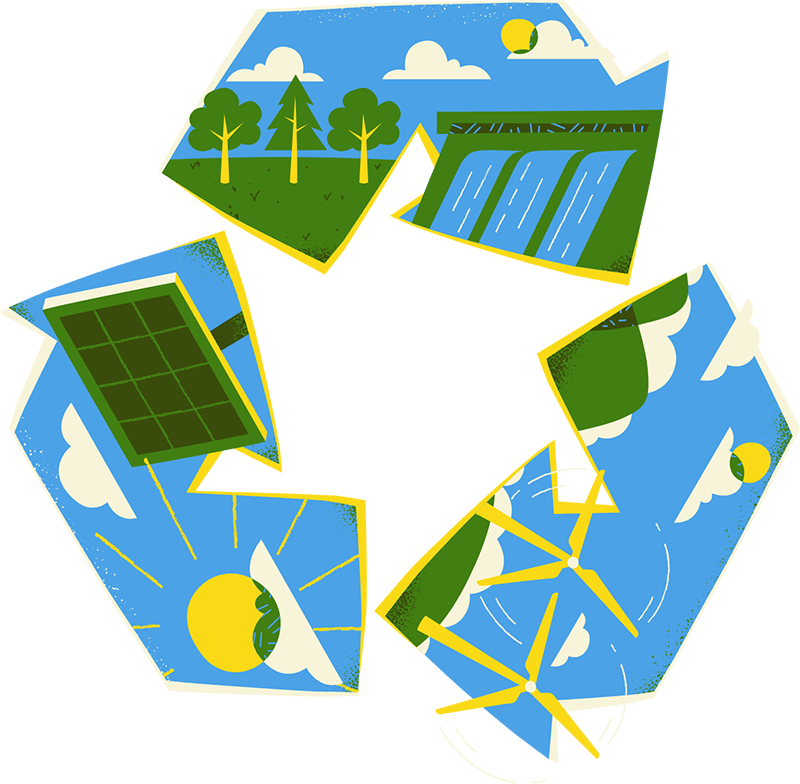
Renewable energy sources – particularly solar and wind – tick all the right boxes when it comes to shaping a sustainable energy future.
The single most valuable aspect of renewable technologies is that they are zero carbon generators – they add energy without adding carbon emissions.
Further to this, they are affordable, and getting cheaper zero marginal cost and rapidly declining capital costs.
Also, the deployment of renewables is job-intensive and can spur economic activity and increased employment.
If we are to decommission South Africa’s coal-fired power plants as soon as feasibly possible, we’re going to have to accelerate the roll out of renewable energy.
However, renewable energy is weather-dependent, variable/intermittent, and less flexible. So, if we’re to have power system flexibility, we will need complementary dispatchable power capacity like gas-to-power and energy storage technologies in order to #energisemzansi.
As we learn more about how renewable energy can be generated, the cost of producing it drops. At the same time, new technology is making for more efficient generation.

As a result, renewable energy is quickly becoming one of the most affordable sources of electricity, with very real benefits for consumers and industry.
Source: IRENA, Lazard, graphic adapted from Our World in Data https://ourworldindata.org/cheap-renewables-growth
South Africa is in a position to generate over 30GW of renewable energy by 2034, which will significantly diversify and strengthen our energy supply options.
Transmission grid expansion determines where renewables can be installed. Because of the way the South African transmission grid has been designed – during the days of coal-fired power stations – there’s a mismatch: new renewable energy plants are being built in the coastal areas (where renewable energy capacity factors are higher), but most of the transmission capacity is available inland.
Source: Eskom Renewable Energy Connection Survey; Eskom 2025 GCCA
Expanding the transmission grid is critical to unlocking the full potential of renewable energy and to #energisemzansi. If the electricity grid isn’t expanded, we won’t be able to get the full benefits of renewables.
As a larger share of power is provided by renewables, the power system will require additional flexibility provided by storage or flexible thermal plants.
Electricity storage encompasses all technologies that can consume electricity, store it and return it later.

By 2025, the contribution of renewable energy to the national grid is likely to increase to between 30% and 40%. We’ll need an expanded – and flexible – storage network to make sure this energy is available to be dispatched when needed. In total, approximately 12 GW of storage will be needed by that time in order to #energisemzansi.
Electricity storage technologies play a vital role in balancing supply and demand by storing energy during periods of oversupply and releasing it during times of undersupply.
Examples of storage technologies include pumped hydro-storage and battery electric storage systems (BESS) such as Lithium-Ion batteries. Alternatives for long-duration storage (e.g., hydrogen) are slowly becoming commercially viable.
Battery electric storage is the most scalable and cost-effective option for short-duration (<8 hour) electricity storage.
The cost of battery electric storage systems (BESS) is coming down rapidly. It is the most scalable and cost-effective option for short duration storage, around 8 hours or less.
Until 2035, Pumped Hydro Storage and BESS will be the dominate storage types based on South Africa’s storage and discharge needs.

There are a number of topics to be discussed in more detail in order to speed up the rollout of renewables including:
#EnergiseMzansi
Rolling out renewables

Physical Address:
12 Desmond Street,
Kramerville, 2090, South Africa
Enquiries:
Email: info@energycouncil.org.za
© 2025 Energy Council of South Africa.
All rights reserved | Privacy Policy | Fraud and Unethical Conduct
| Cookie | Duration | Description |
|---|---|---|
| cookielawinfo-checkbox-analytics | 11 months | This cookie is set by GDPR Cookie Consent plugin. The cookie is used to store the user consent for the cookies in the category "Analytics". |
| cookielawinfo-checkbox-functional | 11 months | The cookie is set by GDPR cookie consent to record the user consent for the cookies in the category "Functional". |
| cookielawinfo-checkbox-necessary | 11 months | This cookie is set by GDPR Cookie Consent plugin. The cookies is used to store the user consent for the cookies in the category "Necessary". |
| cookielawinfo-checkbox-others | 11 months | This cookie is set by GDPR Cookie Consent plugin. The cookie is used to store the user consent for the cookies in the category "Other. |
| cookielawinfo-checkbox-performance | 11 months | This cookie is set by GDPR Cookie Consent plugin. The cookie is used to store the user consent for the cookies in the category "Performance". |
| viewed_cookie_policy | 11 months | The cookie is set by the GDPR Cookie Consent plugin and is used to store whether or not user has consented to the use of cookies. It does not store any personal data. |
A Power Purchase Agreement (PPA) is a long-term contract between a buyer and a supplier of electricity that defines the terms of the agreement.
Multi-market system – a hybrid market model designed to accommodate various defined transactions (market transactions, physical bilateral transactions and regulated transactions).
Scheduling supply to meet current demand for electricity
Electricity storage encompasses all technologies that can consume electricity (e.g., charge in times of oversupply) and return it later (e.g., discharge in times of undersupply).
The capacity factor is the ratio of the actual electrical energy output over a certain period of time to the maximum possible output if the power source was operating at full capacity all the time. Essentially, it illustrates the efficiency and dependability of an energy source.
A transmission grid is an interconnected network of electrical transmission lines that moves electricity from power plants to distribution systems and end users
Variable renewable energy (VRE) or intermittent renewable energy sources (IRES) are renewable energy sources that are not adjustable due to their fluctuating nature, such as wind power and solar power
Capital costs are fixed, one-time expenses incurred on the purchase of equipment used in the production of goods
The cost added by producing one additional unit of a product or service.
Renewable energy refers to energy generated from a source that is not depleted when used
Liquefied natural gas (LNG) is natural gas that has been cooled down to liquid form for ease and safety of non-pressurized storage or transport.
Republic of Mozambique Pipeline Investments Company
A petajoule (PJ) is a unit of energy measurement that is equal to one million billion joules (10 to the power 15). It can also be expressed as 278 gigawatt hours. One petajoule is equal to 31.60 million cubic meters of natural gas.
Dispatchable generation refers to sources of electricity that can be programmed on demand at the request of power grid operators, according to market needs. Dispatchable generators may adjust their power output according to an order.
Domestic gas is natural gas found underground within a county’s borders
Energy Availability Factor (EAF) = measure of generation performance, electricity available to be generated. EAF is the difference between the maximum availability and all unavailabilities expressed as a percentage
Particulates are microscopic particles of solid or liquid matter suspended in the air. Sources of particulate matter can be natural or anthropogenic. They have impacts on climate and precipitation that adversely affect human health, in ways additional to direct inhalation.
Nitric oxide (NO) and nitrogen dioxide (NO2) are two gases whose molecules are made of nitrogen and oxygen atoms. These nitrogen oxides contribute to the problem of air pollution, playing roles in the formation of both smog and acid rain. They are released into Earth’s atmosphere by both natural and human-generated sources.
Sulfur oxides are a group of molecules made of sulfur and oxygen atoms, such as sulfur dioxide (SO2) and sulfur trioxide (SO3). Sulfur oxides are pollutants that contribute to the formation of acid rain, as well as particulate pollution. Some are released into Earth’s atmosphere by natural sources, but most are the result of human activities.
Net Zero means cutting carbon emissions to a small amount of residual emissions that can be absorbed and durably stored by nature and other carbon dioxide removal measures, leaving zero in the atmosphere.
Nationally Determined Contributions are the commitments that countries make to reduce their greenhouse gas emissions as part of climate change mitigation.
The Paris Agreement is a legally binding international treaty on climate change. It was adopted by 196 Parties at the UN Climate Change Conference (COP21) in Paris, France, on 12 December 2015.
The energy trilemma is a framework that energy policymakers use to balance three objectives:
likely to receive funding
The EU’s Carbon Border Adjustment Mechanism (CBAM) is the EU’s tool to put a fair price on the carbon emitted during the production of carbon intensive goods that are entering the EU, and to encourage cleaner industrial production in non-EU countries
An integrated system brings together several elements to create single cohesive unit
Green hydrogen is hydrogen produced by the electrolysis of water, using renewable electricity. Production of green hydrogen causes significantly lower greenhouse gas emissions than production of grey hydrogen, which is derived from fossil fuels without carbon capture.